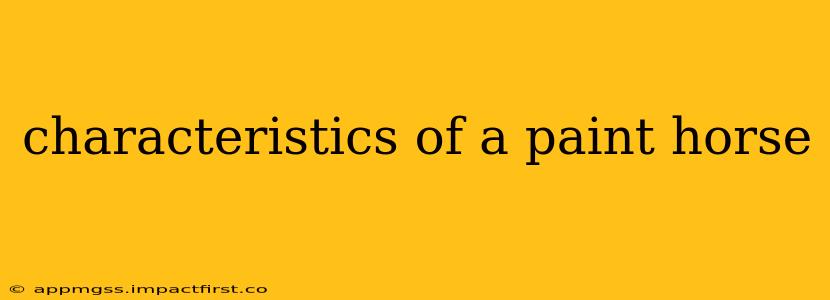The American Paint Horse is a breed known for its striking coat patterns, athleticism, and versatility. But what exactly defines a Paint Horse? This comprehensive guide delves into the key characteristics, exploring everything from their distinctive coloring to their temperament and uses.
What are the main coat characteristics of a Paint Horse?
The most defining characteristic of a Paint Horse is, undoubtedly, its coat. Unlike many other breeds, the Paint Horse's coat isn't defined by a single color, but rather by a specific pattern of two or more colors. These patterns are broadly categorized into tobiano and overo, though variations exist within each.
- Tobiano: This pattern is characterized by large, rounded patches of white that typically cross the horse's back. The white often extends down the legs, and the head usually has a solid color.
- Overo: Overo patterns are more complex and varied. They often feature irregular, blotchy markings that rarely cross the horse's back. The white often covers the belly and flanks, and the head may also have white markings. There are several sub-types of overo patterns, including frame overo, sabino, and splash white. It's crucial to note that some overo patterns can be associated with a genetic condition called Lethal White Syndrome (LWS), hence responsible breeding practices are paramount.
What is the temperament of a Paint Horse?
Paint Horses are generally known for their calm, gentle, and willing temperaments. They're often described as intelligent and responsive, making them ideal partners for both experienced and novice riders. However, individual personalities can vary, and proper training and handling are crucial for any horse, regardless of breed.
What are the different types of Paint Horses?
While the coat pattern is the primary differentiator, the American Paint Horse Association (APHA) doesn't officially categorize Paint Horses into "types" beyond the tobiano and overo pattern distinctions. The variations within these patterns, and the combination with various base colors, create a huge diversity in appearance.
How big are Paint Horses?
Paint Horses are generally considered to be medium-sized, with mature horses ranging from 14.2 to 16 hands high (4.7 to 5.3 feet). However, size can vary based on lineage and individual genetics.
What are Paint Horses used for?
The versatility of the Paint Horse is another key characteristic. Their athleticism and intelligence make them suitable for a wide range of disciplines, including:
- Western riding: Events like reining, cutting, and roping are popular choices for Paint Horses.
- English riding: They can also excel in dressage, jumping, and even eventing.
- Trail riding: Their calm temperament makes them ideal partners for leisurely trail rides.
- Pleasure riding: Many Paint Horses are simply enjoyed as companion animals and for casual riding.
Are Paint Horses good for beginners?
The gentle temperament of many Paint Horses makes them a potentially good choice for beginners, but this is not a guarantee. A horse's individual personality, training, and experience are crucial factors to consider when choosing a horse for a beginner rider. Experienced guidance from a qualified instructor is always recommended.
What is the difference between a Paint Horse and a Pinto Horse?
While the terms "Paint" and "Pinto" are often used interchangeably, there is a key distinction. "Pinto" is a general term referring to horses with two or more colors, while "Paint Horse" refers specifically to those registered with the American Paint Horse Association (APHA). The APHA has specific requirements for registration, including parentage and coat pattern criteria.
This detailed overview provides a comprehensive understanding of the defining characteristics of a Paint Horse. Remember that while breed characteristics offer a general guideline, each horse is an individual with its own unique personality and abilities. Proper training, care, and responsible ownership remain essential for all equine partners.
